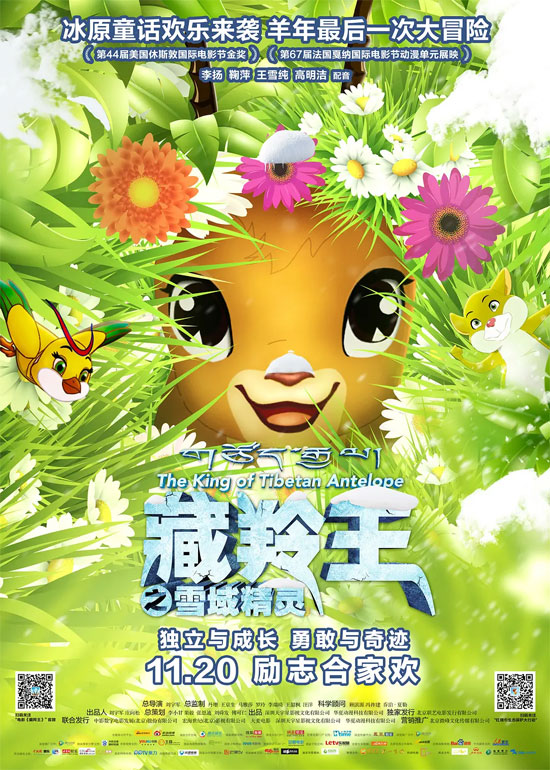Film Name: 藏羚王之雪域精灵 / The King of Tibetan Antelope

It’s been ages since I’ve seen a Chinese-made 2D animation so rich in Disney-esque style. The depiction of Tibetan antelope expressions and movements carries a rare sense of performance rarely seen in domestic animations. The portrayal of antelope herds—especially those in motion—shows no signs of frame skipping or simplification. In other words, it brims with the animators’ meticulous dedication. Of course, the film is even more saturated with a profound love for the creatures of the snowy plateau.
It’s been two days since I watched the film, yet images of the young Tibetan antelopes still frequently appear before my eyes. Especially during that tear-jerking moment at the end when the real Tibetan antelope mother appears—I felt my heart melt. Equally vivid are the breathtaking scenes depicting the Qinghai-Tibet Plateau’s natural landscapes. Whether it’s the endless snow-capped mountains, the fiery crimson sunset clouds, the volcanic ash slopes, or the intermittent geysers, each frame evokes a sense of awe and wonder. Without a doubt, this film boasts the most stunning backdrop I’ve ever seen in a Chinese animated feature—unmatched.
The film not only gave me a sense of the majestic scale of the Tibetan antelope migration but also made me feel as if I were witnessing the unique phenomenon of birds and rodents sharing the same burrows firsthand. This sparked a deep curiosity about the Qinghai-Tibet Plateau within me. The film’s unique approach of interweaving footage of real Tibetan antelopes into the animation further allowed the audience to feel the authenticity behind the fantasy.
Against this backdrop of immersive experiences, the film’s slightly didactic message—to protect the Tibetan antelope, the spirit of the snowy plateau—feels entirely natural, never tedious, profoundly persuasive, and truly worthy of action. I am willing to be educated by such a message. Just like the father and son sitting in front of me during the screening—the father had initially planned to check his phone as soon as the film started, but he was instantly captivated by the images and watched from beginning to end.
The film’s storyline is an area where it could be improved. While the current plot already surpasses the average standard of domestic animation, more meticulous refinement could significantly enhance its emotional impact, better complementing its stunning visuals. For instance, the climactic confrontation between the hunter and the Tibetan antelope at the mountain pass feels somewhat rushed. What truly compels the hunter to stop should be more than his son’s intervention—it should be his own profound realization of the antelope’s majesty as a spirit of the snowy realm. His decision to spare them should stem from reverence, not mere gratitude.
The film could have used close-ups to capture the pure gaze of the young Tibetan antelope king, reflecting the call of the Qinghai-Tibet Plateau’s mountains. It could even have shown the hunter witnessing the same sacred light his son saw during his rescue, making him feel nature’s irresistible power. A pivotal exchange should occur between him and his men: when the men question why he spared the antelope, he delivers a powerful, spine-tingling declaration—something like: “Look into its eyes. If I kill it here, the entire mountain will never forgive me.” Only such words can condemn the evildoers in reality and make people feel the sacredness of the snow-covered realm’s spirit.
From a plot perspective, the film does simplify some elements. For instance, the wolves are ultimately defeated by an avalanche, which feels somewhat anticlimactic. Similarly, when the young Tibetan antelope king and his bird and mouse companions seek shelter from winter’s blizzards in a cave, the next scene jumps straight to spring. How did they endure that harsh winter? Aside from the flying flowers and butterflies, the film lacks cohesive foreshadowing and resolution, making the narrative feel overly linear and coincidental.
Finally, regarding the character arc of the young Tibetan antelope, it feels somewhat underdeveloped. Specifically, how it overcomes the trauma of losing its mother isn’t clearly depicted. If I were designing this, I might have started with the young antelope being too afraid to leap over the cliff, only to have its mother carry it across. But then the mother is shot by hunters and falls off the cliff, instilling an innate fear of cliffs in the young antelope. This fear directly impacts his later attempts to learn mountain climbing. His final showdown with the wolf pack should present him with the ultimate test: the necessity to leap over the cliff. Only then should he overcome this psychological shadow, using the leap as a rite of passage to achieve inner growth.
That said, it remains an impressive and excellent domestic animated film.
Please specify:Anime Phone Cases » The King of Tibetan Antelope 2015 Animation Film Review: The Tibetan antelope often appears before my eyes.